Rain Alarm Project is a simple but very useful project that detects Rain (Rain Water) and automatically triggers an alarm or buzzer.
Water is a basic need in every one’s life. Saving water and proper usage of water is very important. Here is an easy project which will give the alarm when there is rain, so that we can make some actions for rain water harvesting and also save the rain water for using it later.
With the help of saving this rain water through rain water harvesting, we can increase the levels of underground water by using underwater recharge technique.
Outline
ToggleRain Alarm Project
Rain water detector will detect the rain and make an alert; rain water detector is used in the irrigation field, home automation, communication, automobiles etc. Here is the simple and reliable circuit of rain water detector which can be constructed at low cost.
In this project, we have designed a simple Rain Alarm Circuit, which, upon detecting rain, will activate a buzzer. Based on the buzzer, we can take necessary actions.
Circuit Diagram
The circuit diagram from the Rain Alarm Project is shown in the below image.
Components Required
- 1 x Small Rain Sensor
- 1 x 555 Timer IC
- 1 x BC548 NPN Transistor
- 2 x 2N2222 NPN Transistor
- 1 x Bright White LED
- 1x 1N4007 PN Junction Diode
- 1 x 220 KΩ Resistor (1/4 Watt)
- 1 x 330 Ω Resistor (1/4 Watt)
- 1 x 10 KΩ Resistor (1/4 Watt)
- 1 x 470 KΩ Resistor (1/4 Watt)
- 2 x 3.3 KΩ Resistor (1/4 Watt)
- 1 x 68 KΩ Resistor (1/4 Watt)
- 1 x 22 µF Capacitor (Polarized)
- 2 x 100 µF Capacitor (Polarized)
- 1 x 10nF Ceramic Capacitor (Code – 103)
- 1 x 100pF Ceramic Capacitor (Code – 101)
- 1 x Buzzer (or Speaker – 8Ω)
- Connecting Wires
- Breadboard
- 12V Power Supply
Rain Alarm Project Block Diagram
The block diagram of the Rain Alarm Project is shown in the following image. The three main components of the project are the Rain Water Sensor, 555 Timer IC and Buzzer.
When the Rain Water Sensor detects the Rain, it sends a signal to the 555 Timer. The 555 Timer IC, which is configured in its Astable Mode, will then activate the Buzzer.
Rain Water Sensor
The Rain Water Sensor used in this project is shown in the image below. It is a simple sensor and it is an easy to use tool for detecting rain. It can act as a simple switch, where the switch is normally open and when there is rain, the switch closes.
Even though Rain Water sensor is the main component in the circuit. We need not to go and buy in the market or online. We can do it ourselves just by taking the piece of Bakelite or Mica board and aluminium wire.
Bakelite or Mica board should be made completely flat and aluminium wire should be pasted on the flat board as shown in the figure below. Care should be taken that there should be no spaces between the wire and board.
When the rain water sensor is completed, it should get connected to the circuit and voltage should be passed through the wires.
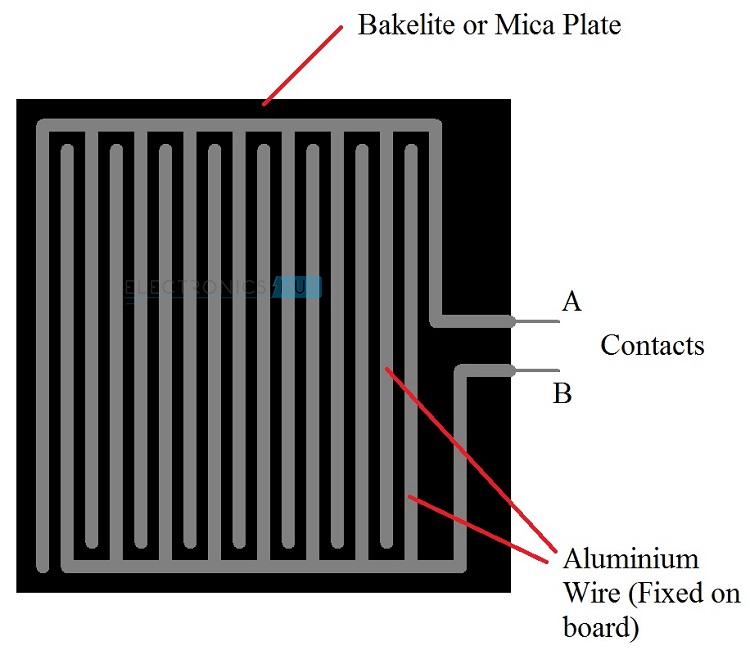
If there is rain, the water drops will fall on the rain sensor, which will form a conductive path between the wires and it also decreases the resistance between the contacts.
As a result, the wires on the sensor board will conduct and trigger the NE555 timer through the transistors circuitry. Once NE555 is triggered, it will make the output pin high and which will make the buzzer to make alarm.
Working of the Circuit
We will see the working of the simple Rain Sensor Alarm Circuit Project. When rain falls on the sensor, the Aluminium Wires on the Sensor Board will start conducting and close the path between the supply and base of the transistor Q2.
As a result, the Transistor Q2 will turn ON, which will also turn ON the Transistor Q1. This will turn ON the Bright White LED connected to the emitter of the Transistor Q1.
When the transistor Q2 is saturated, the capacitor C1 will be shorted and will make the transistor Q3 to be turned ON. C1 will get charged by the resistor R4.
When the Transistor Q3 reaches the saturation mode, the Reset Pin of the 555 Timer IC, which is connected to the emitter of Q3, will be made positive.
The 555 timer is configured in Astable Mode. As the Reset pin of the 555 Timer IC is given positive voltage, it becomes active and we will get a Pulse signal at the output pin 3 of the 555 Timer IC. This will turn ON the buzzer and the alarm is activated.
If you are using a speaker, Capacitor C4, which is connected in between the Pin 3 of 555 timer and the speaker, will block the DC signal and allows only the variations in the signal which makes the speaker to make sound. The diode D1 will not allow any reverse current from the timer.
Because of the resistor R4 and capacitor C1, when the capacitor is completely charged, the transistor Q3 will get in to cut – off mode after sometime.
As a result, the Reset pin of the 555 Timer IC will not receive any positive voltage and the speaker will stop making sound. The time for 555 Timer to make speaker sound depends on the values of C1 and R4.
When there is no rain, the aluminium wire on the sensor will not conduct as they do not have any conduction path (open circuit). As a result, the sensor cannot trigger the 555 Timer IC and there will be no alarm.
Note:
- Rain senor should be kept in the open place at 30 to 40 degrees from the ground. As a result, rain water will not be present on the sensor for long time.
- This circuit will automatically switch of the alarm after sometime and LED will glow continuously until the rain stops.
Rain Alarm Project Circuit Applications:
- In the irrigation, it will detect the rain and immediately alert the farmer.
- In automobiles, when the rain detector detects the rain it will immediately active the wipers and inform the driver.
- In communications, it will boost the power of the antenna and increase the signal strength to send or receive the signals.
- In normal house hold, with the help of rain water detector we can automatically save the rain water. (This can be done only when home automation is done and there is proper equipment to save the rain water. In this, rain water detector will detect the rain and helps to switch ON the equipment which will automatically save rain water for different purposes).
- This can also be used if there is a chemical rain also. This is very common in industrial areas.

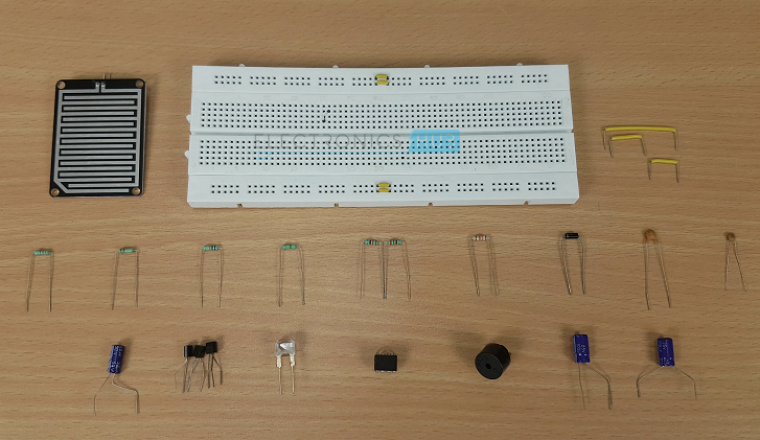
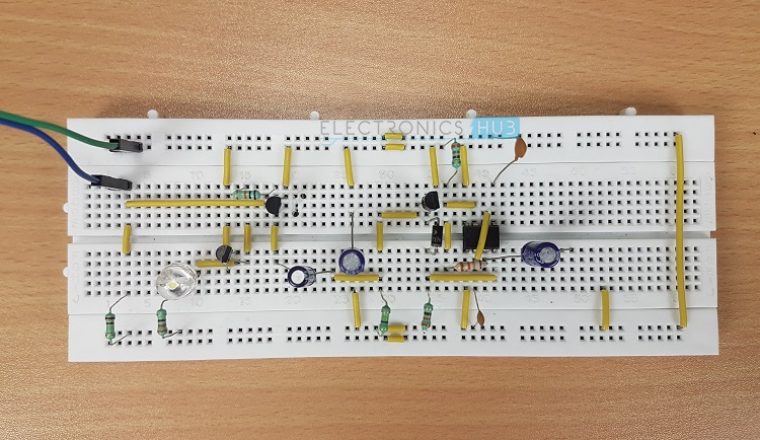
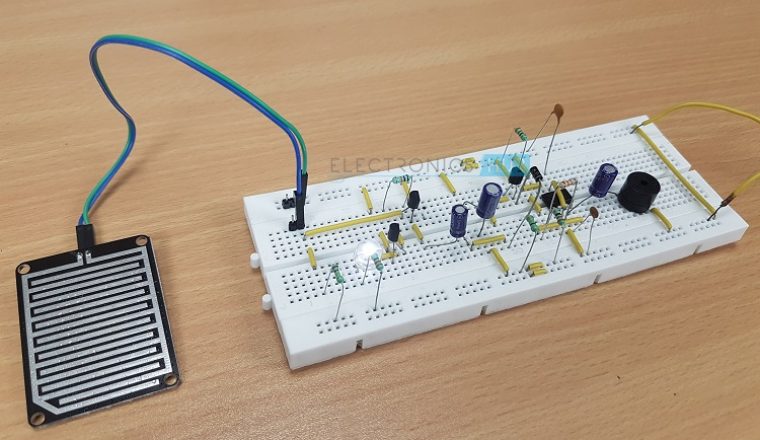
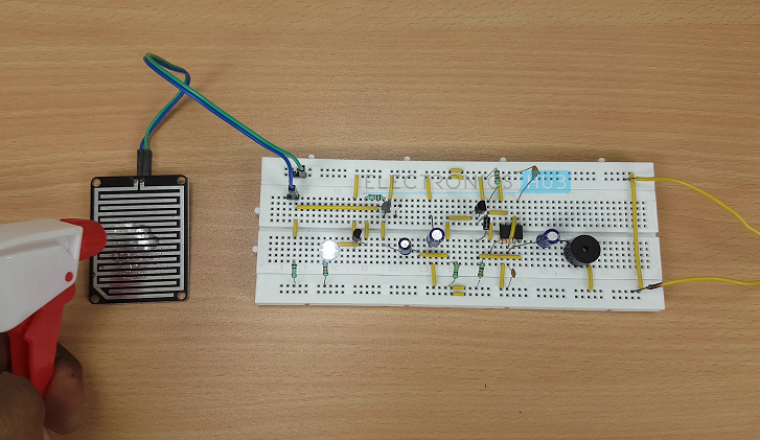


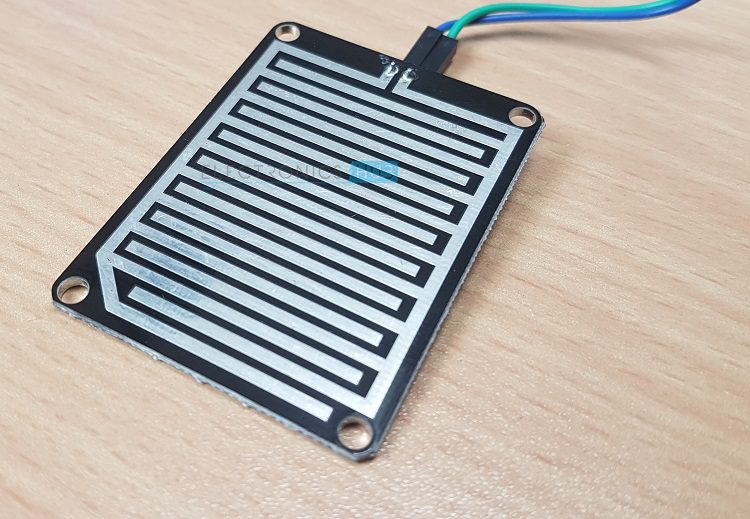

45 Responses
Useful!
how can we calculate the current from the sensor like what is the resistance of the sensor.
Because we need to know the resistance in order to set the bias for transistor. How did you do that, can you tell me?
to know the unknown resistance of a sensor simply keep the two terminals in a multimeter device and keep the device in resistance mode. automatically with in a fraction of seconds you can found the unknown resistance of the sensor you are using in your project………
you can use digital multimeter to found the unknown resistance of a electronic device…..
What should be the Voltage that we need to pass through the wires?
useful
THANK YOU……………..
Is that the circuit is work?? Because I’m in plan of doing this as my final year project. Please reply me fast as possible. Thank you very much.
hi
1. Where is the power supply?
2. Q1 connected uncorrectly because it’s connected as reverse bias and the LED never work
3. This CCT not work properly.
for second point what should we do for correct workin?
Where is the Battery / Power Supply in this circuit?
is 12v
usesful!!!!!! i will try……
use 15v dc adapter for power supply
Every thing are defined but voltages not showing how much required ensure it ?
please give what should be the voltage and correct connections
Sir please send me the hr202 humidity sensor background
hi i need the component details plzz help me out
hello vl u plz clarify wer 2 connect the voltage supply
can any one please clarify where to connect the power suppy and…..what should be the range….means perticullarly what should be connected and where…
Connect Vcc to the 555 timer vcc and ground pin to C2…
How can we create the rain detector
What is the cost for whole project?
Sir, give a PCB lay out diagram to make the project finishing.
What is the cost of this?iam taking this as my final year project..please tell me
What should be the ampere ratings of the 12 V power supply
It’s very useful in irrigation field
fantastic
What is the uses of this one
Are the c1 and c2 capacitor meeting, is there a node?
And even the buzzer isn’t buzzing. The output voltage is very low.
No. C1 and C2 do not meet. Try to drive the buzzer through a Transistor.
Help friends, I want to know why it must be this resistor values to be used
I want to know how the values are calculated as well.
Useful!! Helped me for science fair in our school
The nice circuit I will try it.
WHAT IS TRANSISTOR Q1 Q2 Q3?
Useful for students for their summer vacation assignments, also it can be of great value to anyone interested in doing mechanical engineering at home with readily available materials. I would rate it 10/10!!
Can it detect even the smaller water drops?
once after the buzzer stops its sound does it start again if the rain continues
If we use 9v battery instead of 12v power supply , Is this circuit will operate buzzer or not?
THANK YOU
What do you think is the concept of this project?
From where we can buy rain sensor
you can make a good simple rain alarm using just two transistors [BC109] one resistor [330K] and one capacitor.[0.1uf] A simple censor that works well is made with a piece of veroboard connecting intermediate tracks together. Any small L.S. 0-100 ohms will give a good response and can be powered from 3-9 volts. So why all the fuss and bother with a 555 chip and all the components, being a total waste of time and money for an alarm that is no better. I have used my circuit, which has given me good service for over 5 years, replacing the 9 volt battery only once. .
what is the role of c1 and c2